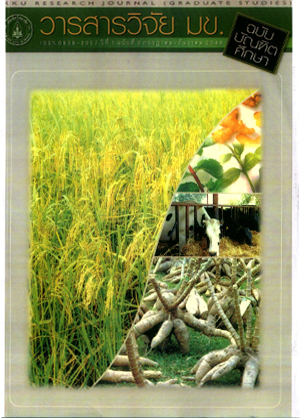Salt Tolerance in Rice: Glasshouse Screening, field experiment and Salt-induced Polypeptides (การทนเค็มในข้าว : การทดสอบในเรือนทดลอง, ภาคสนามและโปรตีนที่ถูกชักนำด้วยความเค็ม)
Keywords:
Rice, Salt tolerance, Salt -induced PolypeptidsAbstract
Salt tolerance of 98 Thai rice varieties was determined at seed ling stage based on the visual symptoms of salt injury and Na-K ratio in shoots. The rice varieties test were classified into 3 groups: moderately tolerant, susceptible and highly susceptible. In a field experim ent conducted i n saline soil, eight varieties were selected for eval uat ion of salt tolerance based on growth, yield and yield compon ent s. Salt tolerance in rice showed positive correlation with number of productiv e tillers per plant, followed by st raw yield per plant, panicle length and num ber of spikelets per panicle. Protein changes induced by N aCl stress were investi gated in root s of rice seedl ings using SOS- PAGE . Intensity of a 90 ki lodalton polypeptide increased in cvs. Leu ang Yai , Leuang Anan, K hao Med Lek and Pokka li but not in KOML 105.
การทนเค็มของข้าวไทย 98 สายพันธุ์ในระยะต้นกล้า วัดได้จากอาการผิดปกติที่เกิดจากความเป็นพิษของเกลือและค่าอัตราส่วนของโซเดียมต่อโพแทสเซียมในส่วนของต้น จำแนกการทนเค็มของข้าวไทยได้ 3 กลุ่มคือ ทนเค็มปานกลาง, ไม่ทนเค็มและไม่ทนเค็มมาก การศึกษาการทนเค็มข้าว 8 สายพันธุ์ในพื้นที่ดินเค็มวัดตากค่าเจริญเติบโต ผลผลิตและองค์ประกอบของผลผลิต พบว่า การทนเค็มของข้าวสัมพันธ์กับจำนวนหน่อต่อต้น ตามด้วยน้ำหนักฟางแห้งต่อตัน ความยาวรวง และจำนวนเมล็ดต่อรวง การศึกษาการเปลี่ยนแปลงของโปรตีนที่ถูกชักนำด้วยเกลือโซเดียมคลอไรด์ในเนื้อเยื่อของรากข้าวโดยใช้เทคนิค SDS-PAGE พบว่า โพลี่เปปไทด์ขนาด 90 กิโลคาลตันถูกชักนำให้สร้างมากขึ้นในรากเมื่อได้รับความเค็มในข้าวพันธุ์ เหลืองใหญ่, เหลืองอนันต์, ขาวเม็ดเล็ก และพอลคาลี แต่ไม่พบในข้าวพันธุ์ขาวดอกมะลิ 105



